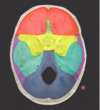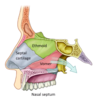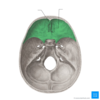Skull anatomy Flashcards
(54 cards)
how can the bones of the brain be divided? [2] desribe basic roles of each
neurocranim: cranial vault: protect brain
visecerocranium: facial skeleton: cavities for sense organs, secure teeth, framework of face

how are flat bones of brain formed? [1]
how are flat bones of brain formed? [1]
Intramembranous ossification: the replacement of sheet-like connective tissue membranes with bony tissue.


what are the
red
yellow
light green
purple
blue
bones?

what are the
red: tempora
yellow: sphenoid
light green: temporal bone
purple: parietal bone
blue: occipital
bones?




what is A?
why is it clinically significant? [1]

Pterion
clinically significant: junction of bones so is a weak spot. behind it closely runs the middle meningial artery. trauma here can damage artery easily
what are fontanelles? [1]
what is their function [2]?
what are fontanelles? [1]
wide sutures in new born covered by membrane
function
- allow bone to expand with growth of brain
- allow pressure on skull during birth
which fontanelle do you examine when looking at increase in cranial pressure / dehydation of baby? [1]
anterior fontanelle


which bone houses the middle and internal ear?
parietal
temporal
sphenoidal
lacrimal
ethmoid
which bone houses the middle and internal ear?
parietal
temporal
sphenoidal
lacrimal
ethmoid
which part of the temporal bone contains the organs of hearing?
squamous
external acoustic meatus
petrous part
mastoid process
styloid process
which part of the temporal bone contains the organs of hearing?
squamous
external acoustic meatus
petrous part
mastoid process
styloid process


which bone is this?
temporal
ethmoid
mandible
maxilla
sphenoid

which bone is this?
temporal
ethmoid
mandible
maxilla
sphenoid


which part of the sphenoid does pituitary gland sit it?
anterior clinoid process
greater wing
superior orbital fissure
sella turcicia
posterior clinoid process
which part of the sphenoid does pituitary gland sit it?
anterior clinoid process
greater wing
superior orbital fissure
sella turcicia
posterior clinoid process
what is the green bit? what find in it?
what do you find at the anteiror and posterior ends?

sella tucicia - pituitary gland!
anterior clinoid process
posterior clinoid process



which of the following is the tentorial notch?
A
B
C
D
E

which of the following is the tentorial notch?
A
B
C
D
E
which of the following is the falx cerebri
A
B
C
D
E

which of the following is the falx cerebri
A
B
C
D
E
which of the following is the tentorium cerebellum?
A
B
C
D
E

which of the following is the tentorium cerebellum?
A
B
C
D
E
what are dural venous sinuses? [1]
what are dural venous sinuses? [1]
between periosteal and meningeal layers of dura mater is a network of endothlial lined spaces filled wtih venois blood
































